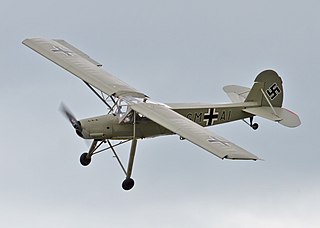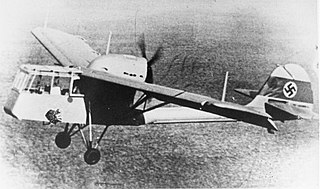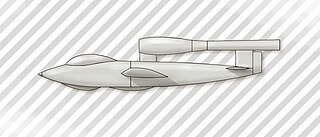Design and development
During the autumn of 1935, the considerable potential of the Fieseler Fi 156 project for the tasks of short-range reconnaissance and aerial observation had prompted the RLM to draw up a requirement for an army cooperation and observation aircraft with its performance parameters. The requirement stipulated the use of the Argus As 10 or the Hirth HM 508 engine and placed emphasis on short field performance, maximum possible allround view for the two crew members, and a wide range of speed. It was intended that the resultant aircraft, which the Siebel Si 201 was also designed to compete for, would be evaluated in competition with the Fi 156.
The Bf 163 closely followed the formula established by the Fi 156 by being a high-wing braced monoplane with a metal structure, automatic leading edge wing slots, double slotted flaps, and an exceptionally tall undercarriage. The aircraft's most interesting feature was the provision for varying the incidence of the entire wing which swivelled on its mainspar, the bracing struts being attached to the fuselage by ball joints and changing their angle with movement of the wing. Construction of the sole prototype was entrusted to Weserflug, though due to its origin with the Bayerische Flugzeugwerke before mid-July 1938, it retained the Bf RLM prefix for the earlier firm.

The Fieseler Fi 156 Storch is a liaison aircraft designed and produced by the German aircraft manufacturer Fieseler. Its nickname of Storch was derived from the lengthy legs of its main landing gear, which gave the aircraft a similar appearance to that of the long-legged, big-winged bird.

The Messerschmitt Bf 108 Taifun is a single-engine sport and touring aircraft designed and produced by the German aircraft manufacturer Bayerische Flugzeugwerke. It featured all-metal construction.
The Gerhard Fieseler Werke (GFW) in Kassel was a German aircraft manufacturer of the 1930s and 1940s. The company is remembered mostly for its military aircraft built for the Luftwaffe during the Second World War.

Alexander Lippisch's Delta IV was a continuation of his work on delta wing designs pioneered in his Delta I, Delta II and Delta III aircraft.

The Henschel Hs 127 was a German bomber that was built as two prototypes, but cancelled without entering mass production.

The Me 209 of 1943 was an attempt to create an enhanced version of the Bf 109, which served as the Luftwaffe's primary fighter aircraft throughout World War II. The Me 209, despite its designation, bore no relationship to the earlier Me 209.

The Argus As 10 was a German-designed and built, air-cooled 90° cylinder bank-angle inverted V8 "low power" aircraft engine, used mainly in training aircraft such as the Arado Ar 66 and Focke-Wulf Fw 56 Stösser and other small short-range reconnaissance and communications aircraft like the Fieseler Fi 156 Storch during, and shortly after World War II. It was first built in 1928.

The Fieseler Fi 167 was a 1930s German biplane torpedo and reconnaissance bomber designed for use from the Graf Zeppelin class aircraft carriers under construction from 1936 to 1942.
The Klemm Kl 151 was a German prototype light passenger aircraft designed by Dr. Hanns Klemm and chief engineer Carl Bucher during World War II. Only one model was built.

The Kokusai Ki-76, or Liaison Aircraft Type 3, was a Japanese high-wing monoplane artillery spotter and liaison aircraft that served in World War II. The Allied reporting name was "Stella".

The Fieseler Fi 97 was a 1930s German four-seat cabin touring and competition monoplane aircraft designed and built by the German manufacturer Fieseler.

The Kobeseiko Te-Gō was a Japanese two-seat STOL experimental reconnaissance aircraft developed by Kobe Steel in 1942 for service in World War II. In accordance with the Army's request, Professor T. Miki, Osaka Imperial University designed and Kobe Seikojo built the Te-Gō. No "Ki" code number was assigned there to since the project was outside the jurisdiction of the Army Aviation Headquarters.

The Klemm Kl 36 is a 1930s German four-seat cabin touring and competition monoplane. It was designed by Klemm and Friedrich Fechner and built by Klemm.

The Siebel Si 201 was a German air observation post and army cooperation aircraft, designed and built by Siebel. Evaluated against other types, the Si 201 did not enter production and only two prototypes were built.

The Junkers EF 126 was an experimental fighter proposed by the German Miniaturjägerprogramm of 1944–1945, for a cheap and simple fighter powered by a pulsejet engine. No examples were built during the war, but the Soviet Union completed both unpowered and powered prototypes.
The German Air Ministry had a system for aircraft designation which was an attempt by the aviation authorities of the Third Reich to standardize and produce an identifier for each airframe type produced in Germany. It was in use from 1933 to 1945 though many pre-1933 aircraft were included and the system had changes over those years. As well as aircraft of the Luftwaffe, it covered civilian airliners and sport planes, due to the RLM handing all aviation-related matters in the Third Reich, both civilian and military in nature.

The Sack AS-6 was a German prototype circular-winged aircraft built privately during the Second World War.

The Horten H.VII was a flying wing fighter-trainer aircraft designed by the Horten brothers in Nazi Germany during World War II.
This page is based on this
Wikipedia article Text is available under the
CC BY-SA 4.0 license; additional terms may apply.
Images, videos and audio are available under their respective licenses.















